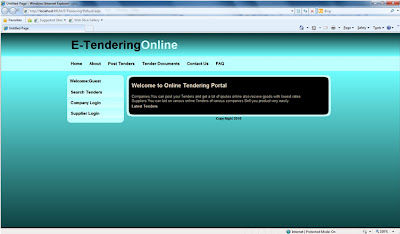Computer Science & Engineering - Miniproject
Electronic Tendering (E-Tendering)
ASP.Net - SQL Server - C#
Abstract:
Electronic Tendering is carrying out the traditional
tendering process in an electronic form, using the internet. E-Tendering (Electronic
Tendering System) is an online service. It provide everyone involved in the
Business industry, especially Suppliers and companies, with an efficient,
secure, simple and cost-effective tools to facilitate the best use of Tender Information
and to enhance our business outcomes - anywhere, anytime.
It
is created with following missions in mind.
- To provide rapid calling of Tender and to reach a huge number of Suppliers, and receive large number of bids from suppliers from anywhere at any time. All the Tender information is at a single button click.
- It also organizes all of the Tender history and bid information that they typically provide to the website at the time of service.
- It also allows the Suppliers to know whether the Tender submitted selected or not in a few seconds.
The
proposed System is an online service system. Here the companies who have a work
or need some good, create a Tender online. The company is a registered User of
the portal. He can manage the tender using the username and password. The
company can create more than one tender at a time. Anybody who visit the site
can see the tender, if supplier satisfy with the tender create a bid to the
tender. Applying to the tender is a simple process. Supplier login into the
site and create a bid in online. The bid reach the company in a second. The
company can evaluate different bids and release the contract to the appropriate
supplier Using E-Tendering the users can:
- Raise Indents as per the requirement ·
- Approve indents online
- Sell Tenders
- Receive Bids
- Award Contract / PO
- Evaluate Tenders
- Create and publish NIT
- Includes a variety of off techniques such as RFPs, quotes, auctions and reverse auctions.
Using
E-Tendering, the suppliers can
- Receive notification of the relevant tenders
- Purchase tenders document
- Submit Bids Online
- Track the status of their bids
The tenders are published by the companies who are in demand of the goods. Using the E-Tendering System, the users of the participating companies will:
- Raise indents as per the requirements
- Approve Indents online
- Create Tender
- Approve Tender and
- Publish Tender online
The users who registered as suppliers of this system will:
- Receive tender notification
- Submit Tenders
The system will auto evaluate the bids of the suppliers and guide the user to select its apt supplier.
The system can be developed using ASP.NET and MSSQL Server or any other web application developer.










